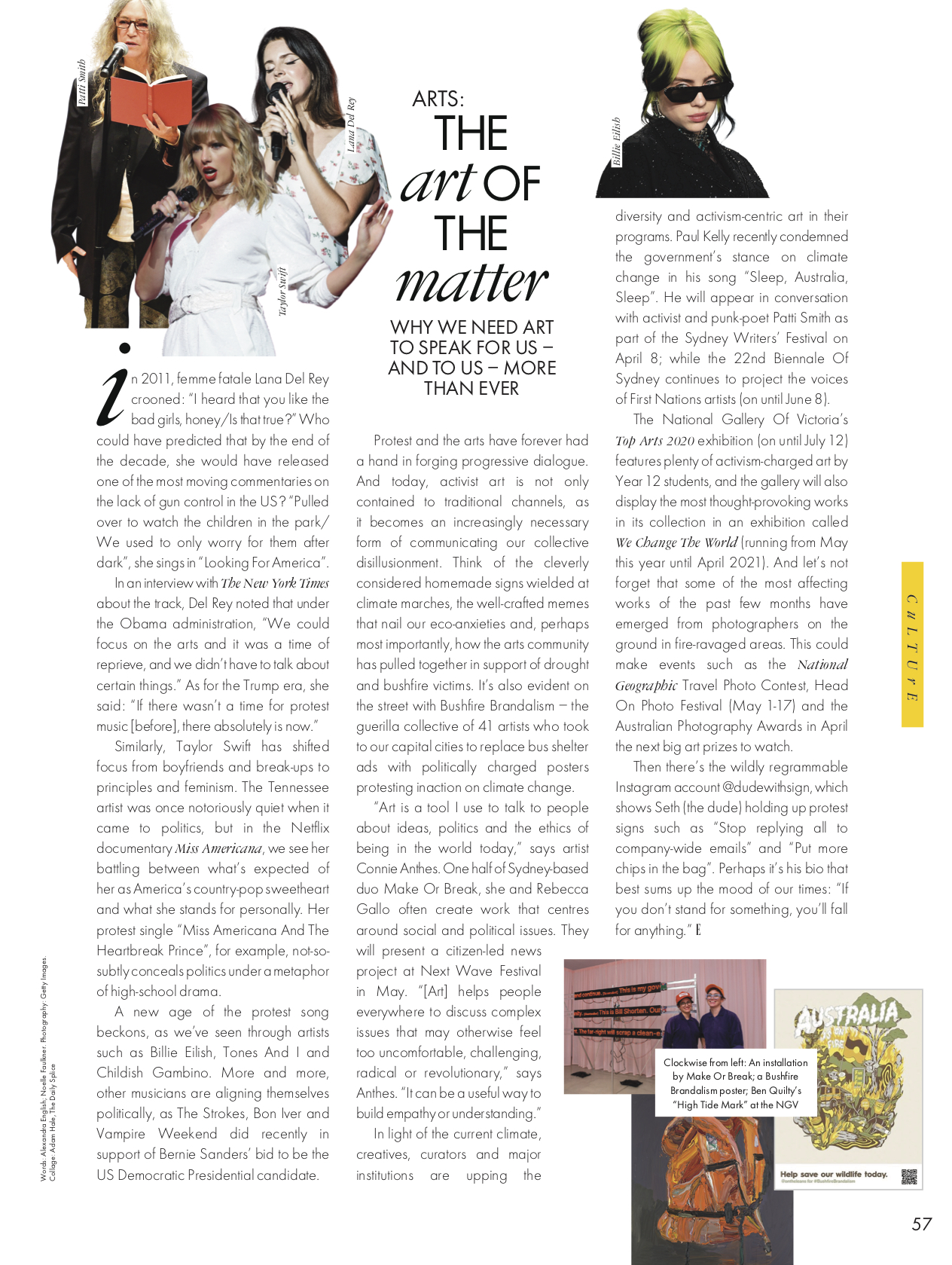
ELLE, April 2020 (PDF)
In 2011, femme fatale Lana Del Rey crooned: “I heard that you like the bad girls, honey/Is that true?” Who could have predicted that by the end of the decade, she would have released one of the most moving commentaries on the lack of gun control in the US? “Pulled over to watch the children in the park/ We used to only worry for them after dark”, she sings in “Looking For America”.
In an interview with The New York Times about the track, Del Rey noted that under the Obama administration, “We could focus on the arts and it was a time of reprieve, and we didn’t have to talk about certain things.” As for the Trump era, she said: “If there wasn’t a time for protest music [before], there absolutely is now.”
Similarly, Taylor Swift has shifted focus from boyfriends and break-ups to principles and feminism. The Tennessee artist was once notoriously quiet when it came to politics, but in the Netflix documentary Miss Americana, we see her battling between what’s expected of her as America’s country-pop sweetheart and what she stands for personally. Her protest single “Miss Americana And The Heartbreak Prince”, for example, not-so- subtly conceals politics under a metaphor of high-school drama.
A new age of the protest song beckons, as we’ve seen through artists such as Billie Eilish, Tones And I and Childish Gambino. More and more, other musicians are aligning themselves politically, as The Strokes, Bon Iver and Vampire Weekend did recently in support of Bernie Sanders’ bid to be the US Democratic Presidential candidate.
Protest and the arts have forever had a hand in forging progressive dialogue. And today, activist art is not only contained to traditional channels, as it becomes an increasingly necessary form of communicating our collective disillusionment. Think of the cleverly considered homemade signs wielded at climate marches, the well-crafted memes that nail our eco-anxieties and, perhaps most importantly, how the arts community has pulled together in support of drought and bushfire victims. It’s also evident on the street with Bushfire Brandalism – the guerilla collective of 41 artists who took to our capital cities to replace bus shelter ads with politically charged posters protesting inaction on climate change.
“Art is a tool I use to talk to people about ideas, politics and the ethics of being in the world today,” says artist Connie Anthes. One half of Sydney-based duo Make Or Break, she and Rebecca Gallo often create work that centres around social and political issues. They will present a citizen-led news project at Next Wave Festival in May. “[Art] helps people everywhere to discuss complex issues that may otherwise feel too uncomfortable, challenging, radical or revolutionary,” says Anthes. “It can be a useful way to build empathy or understanding.”
In light of the current climate, creatives, curators and major institutions are upping the diversity and activism-centric art in their programs. Paul Kelly recently condemned the government’s stance on climate change in his song “Sleep, Australia, Sleep”. He will appear in conversation with activist and punk-poet Patti Smith as part of the Sydney Writers’ Festival on April 8; while the 22nd Biennale Of Sydney continues to project the voices of First Nations artists (on until June 8).
The National Gallery Of Victoria’s Top Arts 2020 exhibition (on until July 12) features plenty of activism-charged art by Year 12 students, and the gallery will also display the most thought-provoking works in its collection in an exhibition called We Change The World (running from May this year until April 2021). And let’s not forget that some of the most affecting works of the past few months have emerged from photographers on the ground in fire-ravaged areas. This could make events such as the National Geographic Travel Photo Contest, Head On Photo Festival (May 1-17) and the Australian Photography Awards in April the next big art prizes to watch.
Then there’s the wildly regrammable Instagram account @dudewithsign, which shows Seth (the dude) holding up protest signs such as “Stop replying all to company-wide emails” and “Put more chips in the bag”. Perhaps it’s his bio that best sums up the mood of our times: “If you don’t stand for something, you’ll fall for anything.”
